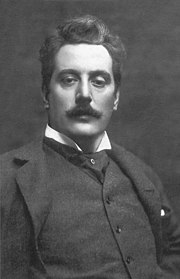Giacomo Puccini's Messa or Messa a quattro voci (currently more widely known under the apocryphal name of Messa di Gloria)[1] is a Mass composed for orchestra and four-part choir with tenor and baritone soloists. Strictly speaking, the piece is a full Mass, not a true Messa di Gloria (which contains only the Kyrie and Gloria and omits the Credo, Sanctus, Benedictus and Agnus Dei).
| Messa | |
|---|---|
| Mass by Giacomo Puccini | |
 The composer | |
| Other name | Messa di Gloria |
| Occasion | graduation exercise |
| Performed | 12 July 1880: Lucca |
| Movements | six |
| Scoring |
|
History
editPuccini composed the Mass as his graduation exercise from the Istituto Musicale Pacini. It had its first performance in Lucca on July 12, 1880. However, the Credo had already been written and performed in 1878 and was initially conceived by Puccini as a self-contained work. Puccini never published the full manuscript of the Messa, and although well received at the time, it was not performed again until 1952 (first in Chicago and then in Naples). However, he re-used some of its themes in other works, such as the Agnus Dei in his opera Manon Lescaut and the Kyrie in Edgar.
At the end of World War II, Fr. Dante Del Fiorentino purchased an old copy of the manuscript of the Messa from the Vandini family in Lucca, imagining it was the original score. However, the autograph, in the possession of the Puccini family, was given by his daughter-in-law to Ricordi, Puccini's publishing firm. The ensuing legal battle was finally resolved by dividing the rights to the work between Ricordi and Mills Music (the publishers of Fiorentino's manuscript). [citation needed]
Structure
edit| Movement | Timing | Title | Movement indication | Solo |
|---|---|---|---|---|
| Kyrie | 5 min. | Kyrie eleison | Larghetto | |
| Gloria | 20 min. | Gloria in excelsis Deo | Allegro ma non troppo | |
| Et in terra pax | Andante | |||
| Laudamus te, benedicimus te | Andante | |||
| Gratias agimus tibi | Andante sostenuto | tenor | ||
| Gloria in excelsis Deo | Tempo I | |||
| Domine Deus | Andante sostenuto | |||
| Qui tollis peccata mundi | Andante mosso | |||
| Quoniam tu solus sanctus | Maestoso | |||
| Cum Sancto Spiritu | Fugue (Allegro) | |||
| Credo | 16 min. | Credo in unum Deum | Andante | |
| Et incarnatus | Moderato | tenor | ||
| Crucifixus | Adagio | baritone | ||
| Et resurrexit | Allegro | |||
| Et in Spiritum Sanctum | Tempo I | |||
| Et unam sanctam catholicam | Larghetto | |||
| Et vitam venturi saeculi | Andantino | |||
| Sanctus – Benedictus | 3 min. 40 s | Sanctus | Andante | |
| Benedictus | Andantino | baritone | ||
| Agnus Dei | 2 min. 40 s | Agnus Dei | Andantino | tenor, baritone |
Recordings
edit- Alfonso Scarano (cond.), Aleš Briscein (tenor), Roman Janál (baritone), Czech Philharmonic Choir Brno, North Czech Philharmonic Orchestra Teplice, 2014
- Martin Elmquist (cond.), Marcello Bedoni (tenor), Jeff Speres (baritone), Luxembourg Philarmonia, Classico, 2010
- Karl Rathgeber (cond.), Bernhard Schneider (tenor), Christian Schmidt-Timmermann (baritone), Prague Philharmonic Orchestra, 2006
- Ingo Schulz (cond.), Daniel Magdal (tenor), Stefan Stoll (baritone), Ölberg chor, 2004
- Pier Giorgio Morandi (cond.), Antonello Palombi (tenor), Gunnar Lundberg (baritone), Hungarian Opera Orchestra and Radio Choir, Naxos, 2002
- Jürgen Budday (cond.), Willi Stein (tenor), Thomas Pfeiffer (baritone), Kantorei Maulbronn (Choir), South West German Radio Baden-Baden and Freiburg Symphony Orchestra, K&K Verlagsanstalt, 2001
- Antonio Pappano (cond.), Roberto Alagna (tenor), Thomas Hampson (baritone), London Symphony Orchestra and Chorus, EMI Classics, 2001
- Wilfried Maier (cond.), Rolph Romei (tenor), Guillermo Anzorena (baritone), Schwäbischer Sängerbund, Württembergische Philharmonie Reutlingen, 1999
- Volker Hempfling (cond.), Kölner Philarmoniker, Motette Records, 1995
- András Ligeti (cond.), Dénes Gulyas (tenor), Balazs Poka (baritone), Chœurs de la Radio-Télévision Hongroise, Orchestre Symphonique de Budapest, Hungaroton Classic, 1992
- Claudio Scimone (cond.), José Carreras (tenor), Hermann Prey (baritone), The Ambrosian Singers, Philharmonia Orchestra, Erato, 1984
- Eliahu Inbal (cond.), Kari Løvaas (soprano),[2] Werner Hollweg (tenor), Barry McDaniel, Chor des Westdeutschen Rundfunks, Radio-Sinfonie-Orchester Frankfurt, Philips Classics, 1975
- Michel Corboz (cond.), William Johns (tenor), Philippe Huttenlocher (baritone), Chœur symphonique et orchestre de la foundation Gulbenkian de Lisbonne, Erato, 1974
Score
editReferences
edit- ^ The mistaken title, Messa di Gloria, was first used in 1951 by the publishers of the first printed edition, Mills Music of New York. See Michele Girardi, Puccini: His International Art, University of Chicago Press, 2002, p. 17. ISBN 0-226-29757-8
- ^ Le solo des soprani du Qui tollis peccata mundi est ici chanté par une soprano solo.
Further sources
- Paul Filmer, Programme Notes: Giacomo Puccini (1858–1924), Messa di Gloria (1880) (sic), North London Chorus, April 2005.
- Gabriella Biagi Ravenni, Breve nota sul nome della Messa, Centro studi Giacomo Puccini, 1999.